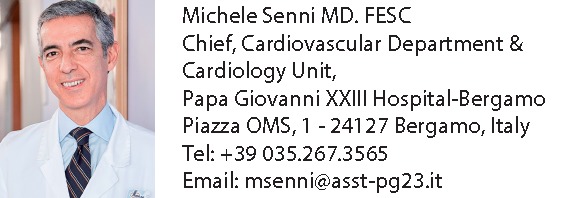Bergamo is the town most affected by the COVID-19 epidemic, not only in the Lombardy Region but also throughout Italy, with >9000 COVID-positive cases, and 2300 ascertained deaths. Unfortunately, the infection is not even sparing young people.
The consequences of the COVID-19 emergency for the entire ‘Papa Giovanni XXIII’ Hospital of Bergamo have been dramatic. At present (mid-March), from a total of 779 hospital beds, >500 are occupied by COVID-positive patients. The 46 beds previously reserved for the ICU (intensive care unit) have been increased to 100, of which 88 are occupied by COVID-positive patients, all of them intubated and with an average age of 61 years.
Due to the shortage of resources , a triage of the patients to be intubated was needed, based on data such as age, presence of comorbidity, degree of respiratory failure severity, and life expectancy.
Although our hospital structure is at the forefront and with great flexibility for organization, during the last month it has run the risk of collapse, facing such a violent epidemic comparable to a tsunami, from which it differs in terms of time, lasting not a single day but more than a month.

Clinicians are living in permanently stressful conditions, caused by concern for their own health and safety, severity of the infection, by seeing patients dying alone, and finally, by exhausting shifts and workload.
Like many other colleagues (so far 12 out of 36 in our Cardiology Unit), I have contracted the infection at the hospital, and, as a consequence, I have been placed in isolation at home for about 2 weeks. This isolation has had personal effects, on family (my whole family was infected) and, not least, professional effects, since I was unable to manage ‘on the spot’ the other different Units of the Cardiovascular Department (Invasive Cardiology, Cardiac Surgery, and Vascular Surgery), except through video conferencing.
My experience, similar to that of many other colleagues, teaches us, the physicians, how the hospitals can be the primary infection vehicle and that priority for the protection of medical staff must be given. To avoid them becoming an infection source, the medical staff must undergo swab tests at the onset of the first symptoms (even mild fever, sore throat, or cough) and all those who enter the hospital, i.e. patients, health staff, or others, must be supplied with and obliged to wear surgical masks.
Our Cardiology Unit, as many other Units of the hospital, has had to face the need to change its own organization. At present, the Cardiology Unit has only 4 ICU beds and 40 ward beds (previously they were 8 and 50, respectively) ∼60% of which are occupied by COVID-19-positive patients. Non-urgent outpatient visits have been cancelled. However, particularly challenging is the management of patients listed for heart transplantation, LVAD patients, and heart transplant patients.
The Cardiology Unit has become the hub for the cardiovascular emergencies of coronary revascularization and electrophysiology of Bergamo Province, which accounts for ∼1 150 000 people. We have modified the cardiology triage system to find functional and operative solutions to the increasing wave of patients arriving at the Emergency Department, and, at the same time, to manage the cardiological emergencies by limiting the infection risk. In detail, we have organized a fast track for patients arriving as emergencies from outside, avoiding the Emergency Department, reducing the infection risk, and allowing them to be directly managed by the cath. lab staff.
Therefore, some possible suggestions that could help cardiologist colleagues to be prepared to start and face this health emergency are: (i) give priority to the protection of hospital health staff; (ii) provide adequate protective systems for the health staff and masks for hospitalized patients, outpatients, helpers, and visitors; (iii) adjust the hospital organization, with units dedicated to the treatment of COVID-positive patients, who should be separated from other patients; (v) change the triage for non-COVID patients; and (vi) use telemedicine or telephone calls by nursing staff to manage patients with chronic cardiovascular disease.
This initial experience is revealing interesting and remarkable aspects to be investigated and clarified in the near future, such as the reduction of admissions for cardiovascular emergencies, such as ST-segment elevation myocardial infarction (STEMI), non-STEMI, and acute heart failure (possible explanations can be that patients are afraid of being infected by COVID-19 in hospital, the difficulty in calling for ambulances and Emergency Services, or lifestyle changes); the impact of cardiovascular comorbidities (ischaemic heart disease, heart failure, diabetes, hypertension) on a patient’s outcomes; the increase of pulmonary thrombo-embolic events; the prevalence of myocarditis; the significance of a slight increase in troponin suggesting a myocardial injury; the difficulty of the differential diagnosis in patients with interstitial pneumonia and heart failure; the necessity of a triage in patients with STEMI and moderate or severe respiratory failure; and, finally, the role of the heart in the high mortality rate of these patients.
By reducing the number of patients admitted for urgent cardiovascular events, an increase of cardiovascular mortality in patients who prefer to stay at home and a sudden, more significant increase in hospitalization for cardiovascular events, especially for heart failure, are likely to be expected immediately after the end of this pandemic, which we should certainly be prepared for.



